Analysis of Care-shield Organization: Innovation and Entrepreneurship
VerifiedAdded on 2022/12/16
|12
|4394
|53
Report
AI Summary
This report provides an in-depth analysis of the Care-shield Organization, a social enterprise focused on providing services to the elderly and children. The report begins with an introduction to innovation and its application within the organization. It then delves into an industry and business sector analysis, exploring the industry life cycle, current challenges (lack of funding, lack of awareness, and lack of proper business strategy), and the attractiveness of the industry using a PEST analysis (Political, Economic, Social, and Technological factors). The report further examines customer pain points through qualitative research methods and outlines market analysis, including segmentation, targeting, and positioning strategies. It also covers competitor analysis, growth and expansion plans, the new venture team, and the business model canvas. The report concludes with a discussion of factors that create opportunities for the organization. References to books and journals are included.
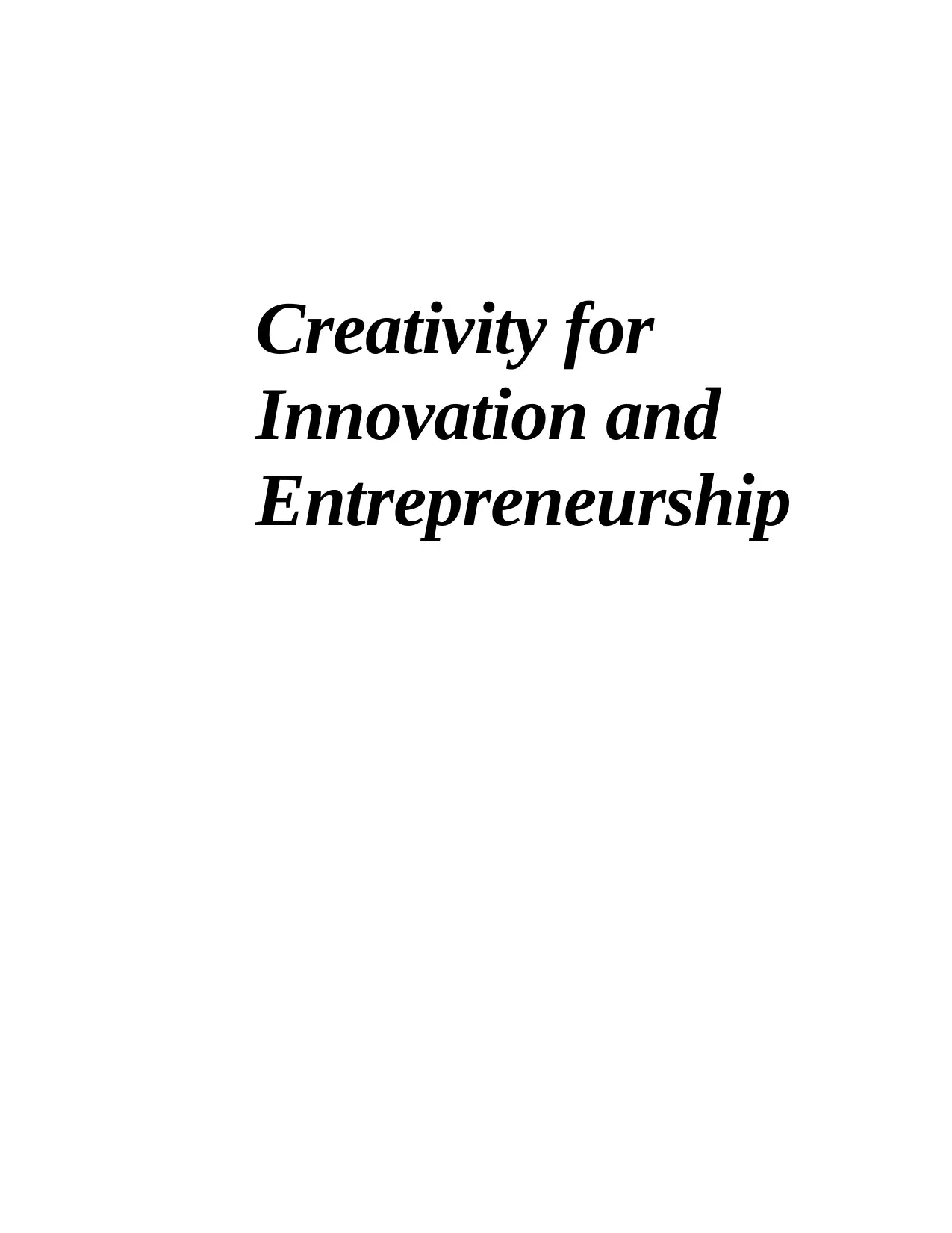
Creativity for
Innovation and
Entrepreneurship
Innovation and
Entrepreneurship
Paraphrase This Document
Need a fresh take? Get an instant paraphrase of this document with our AI Paraphraser
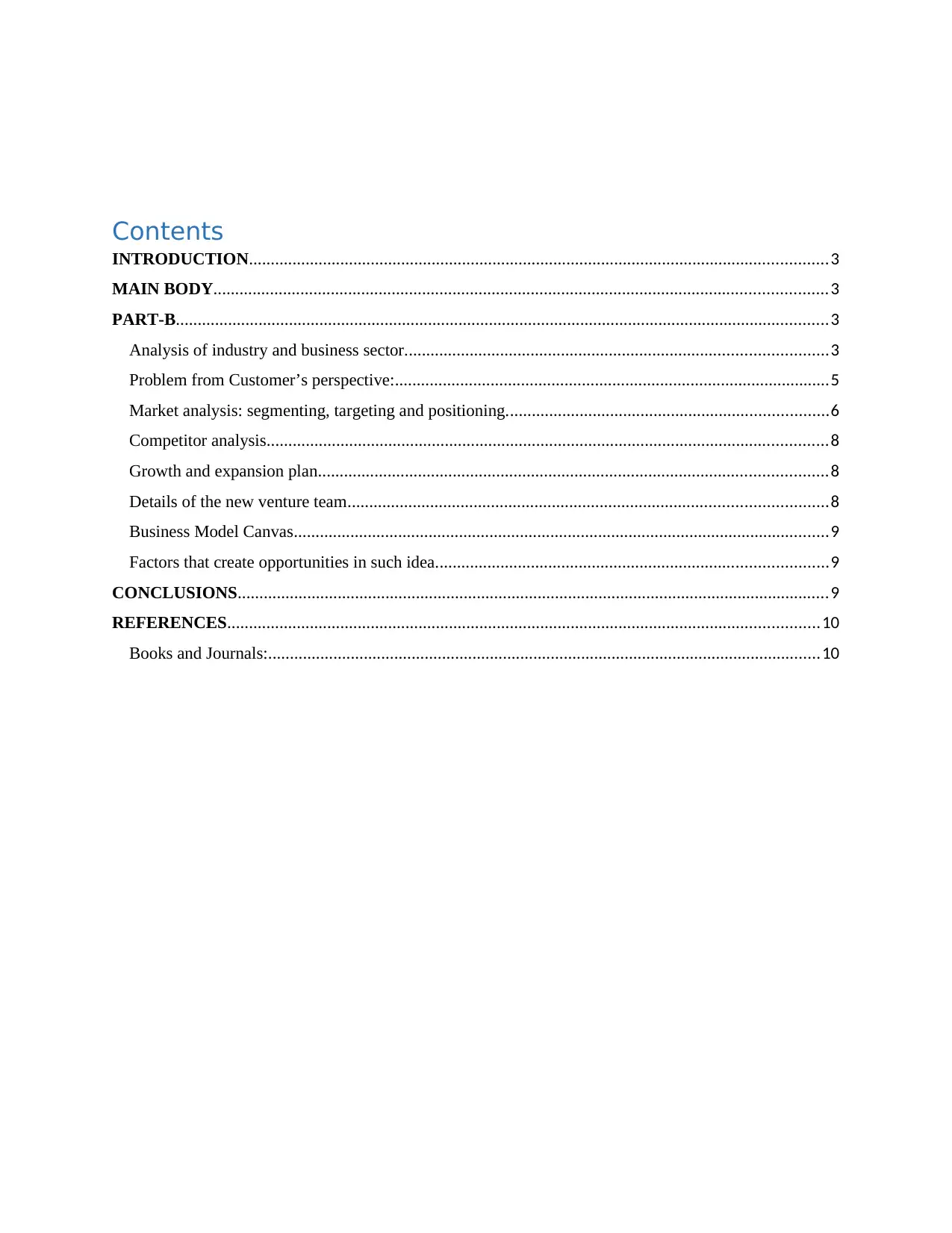
Contents
INTRODUCTION.....................................................................................................................................3
MAIN BODY.............................................................................................................................................3
PART-B......................................................................................................................................................3
Analysis of industry and business sector.................................................................................................3
Problem from Customer’s perspective:....................................................................................................5
Market analysis: segmenting, targeting and positioning..........................................................................6
Competitor analysis.................................................................................................................................8
Growth and expansion plan.....................................................................................................................8
Details of the new venture team..............................................................................................................8
Business Model Canvas...........................................................................................................................9
Factors that create opportunities in such idea..........................................................................................9
CONCLUSIONS........................................................................................................................................9
REFERENCES........................................................................................................................................10
Books and Journals:...............................................................................................................................10
INTRODUCTION.....................................................................................................................................3
MAIN BODY.............................................................................................................................................3
PART-B......................................................................................................................................................3
Analysis of industry and business sector.................................................................................................3
Problem from Customer’s perspective:....................................................................................................5
Market analysis: segmenting, targeting and positioning..........................................................................6
Competitor analysis.................................................................................................................................8
Growth and expansion plan.....................................................................................................................8
Details of the new venture team..............................................................................................................8
Business Model Canvas...........................................................................................................................9
Factors that create opportunities in such idea..........................................................................................9
CONCLUSIONS........................................................................................................................................9
REFERENCES........................................................................................................................................10
Books and Journals:...............................................................................................................................10
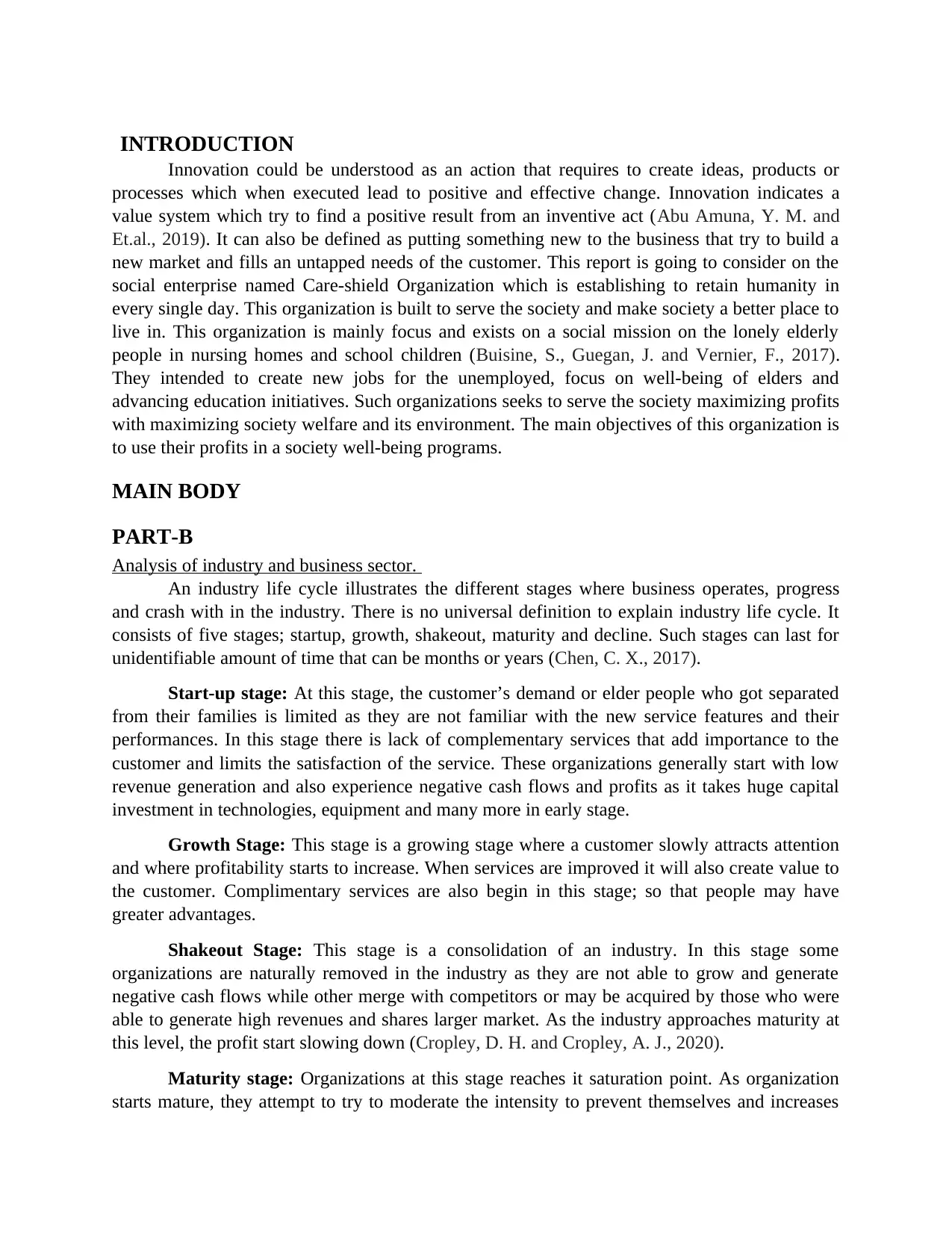
INTRODUCTION
Innovation could be understood as an action that requires to create ideas, products or
processes which when executed lead to positive and effective change. Innovation indicates a
value system which try to find a positive result from an inventive act (Abu Amuna, Y. M. and
Et.al., 2019). It can also be defined as putting something new to the business that try to build a
new market and fills an untapped needs of the customer. This report is going to consider on the
social enterprise named Care-shield Organization which is establishing to retain humanity in
every single day. This organization is built to serve the society and make society a better place to
live in. This organization is mainly focus and exists on a social mission on the lonely elderly
people in nursing homes and school children (Buisine, S., Guegan, J. and Vernier, F., 2017).
They intended to create new jobs for the unemployed, focus on well-being of elders and
advancing education initiatives. Such organizations seeks to serve the society maximizing profits
with maximizing society welfare and its environment. The main objectives of this organization is
to use their profits in a society well-being programs.
MAIN BODY
PART-B
Analysis of industry and business sector.
An industry life cycle illustrates the different stages where business operates, progress
and crash with in the industry. There is no universal definition to explain industry life cycle. It
consists of five stages; startup, growth, shakeout, maturity and decline. Such stages can last for
unidentifiable amount of time that can be months or years (Chen, C. X., 2017).
Start-up stage: At this stage, the customer’s demand or elder people who got separated
from their families is limited as they are not familiar with the new service features and their
performances. In this stage there is lack of complementary services that add importance to the
customer and limits the satisfaction of the service. These organizations generally start with low
revenue generation and also experience negative cash flows and profits as it takes huge capital
investment in technologies, equipment and many more in early stage.
Growth Stage: This stage is a growing stage where a customer slowly attracts attention
and where profitability starts to increase. When services are improved it will also create value to
the customer. Complimentary services are also begin in this stage; so that people may have
greater advantages.
Shakeout Stage: This stage is a consolidation of an industry. In this stage some
organizations are naturally removed in the industry as they are not able to grow and generate
negative cash flows while other merge with competitors or may be acquired by those who were
able to generate high revenues and shares larger market. As the industry approaches maturity at
this level, the profit start slowing down (Cropley, D. H. and Cropley, A. J., 2020).
Maturity stage: Organizations at this stage reaches it saturation point. As organization
starts mature, they attempt to try to moderate the intensity to prevent themselves and increases
Innovation could be understood as an action that requires to create ideas, products or
processes which when executed lead to positive and effective change. Innovation indicates a
value system which try to find a positive result from an inventive act (Abu Amuna, Y. M. and
Et.al., 2019). It can also be defined as putting something new to the business that try to build a
new market and fills an untapped needs of the customer. This report is going to consider on the
social enterprise named Care-shield Organization which is establishing to retain humanity in
every single day. This organization is built to serve the society and make society a better place to
live in. This organization is mainly focus and exists on a social mission on the lonely elderly
people in nursing homes and school children (Buisine, S., Guegan, J. and Vernier, F., 2017).
They intended to create new jobs for the unemployed, focus on well-being of elders and
advancing education initiatives. Such organizations seeks to serve the society maximizing profits
with maximizing society welfare and its environment. The main objectives of this organization is
to use their profits in a society well-being programs.
MAIN BODY
PART-B
Analysis of industry and business sector.
An industry life cycle illustrates the different stages where business operates, progress
and crash with in the industry. There is no universal definition to explain industry life cycle. It
consists of five stages; startup, growth, shakeout, maturity and decline. Such stages can last for
unidentifiable amount of time that can be months or years (Chen, C. X., 2017).
Start-up stage: At this stage, the customer’s demand or elder people who got separated
from their families is limited as they are not familiar with the new service features and their
performances. In this stage there is lack of complementary services that add importance to the
customer and limits the satisfaction of the service. These organizations generally start with low
revenue generation and also experience negative cash flows and profits as it takes huge capital
investment in technologies, equipment and many more in early stage.
Growth Stage: This stage is a growing stage where a customer slowly attracts attention
and where profitability starts to increase. When services are improved it will also create value to
the customer. Complimentary services are also begin in this stage; so that people may have
greater advantages.
Shakeout Stage: This stage is a consolidation of an industry. In this stage some
organizations are naturally removed in the industry as they are not able to grow and generate
negative cash flows while other merge with competitors or may be acquired by those who were
able to generate high revenues and shares larger market. As the industry approaches maturity at
this level, the profit start slowing down (Cropley, D. H. and Cropley, A. J., 2020).
Maturity stage: Organizations at this stage reaches it saturation point. As organization
starts mature, they attempt to try to moderate the intensity to prevent themselves and increases
⊘ This is a preview!⊘
Do you want full access?
Subscribe today to unlock all pages.

Trusted by 1+ million students worldwide
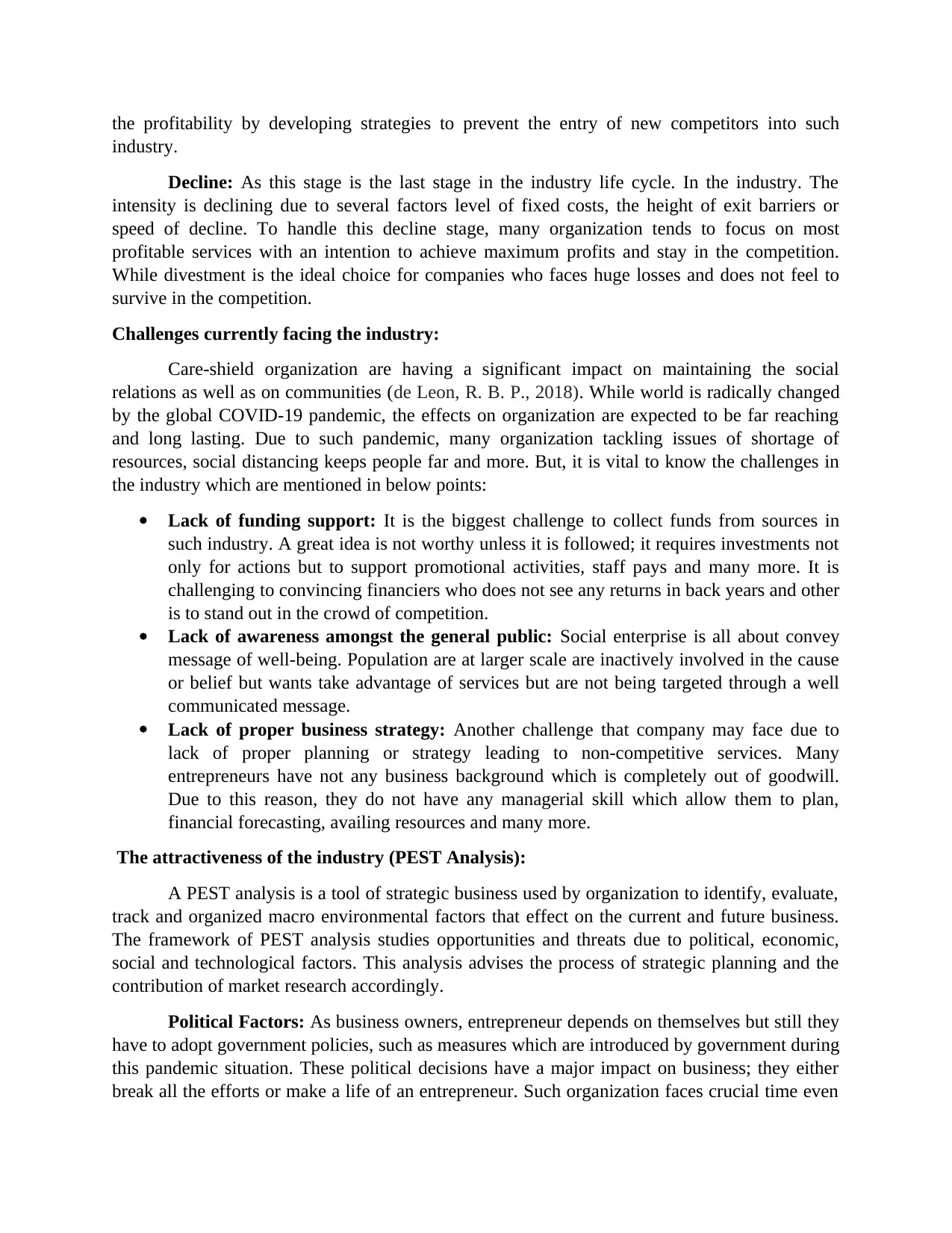
the profitability by developing strategies to prevent the entry of new competitors into such
industry.
Decline: As this stage is the last stage in the industry life cycle. In the industry. The
intensity is declining due to several factors level of fixed costs, the height of exit barriers or
speed of decline. To handle this decline stage, many organization tends to focus on most
profitable services with an intention to achieve maximum profits and stay in the competition.
While divestment is the ideal choice for companies who faces huge losses and does not feel to
survive in the competition.
Challenges currently facing the industry:
Care-shield organization are having a significant impact on maintaining the social
relations as well as on communities (de Leon, R. B. P., 2018). While world is radically changed
by the global COVID-19 pandemic, the effects on organization are expected to be far reaching
and long lasting. Due to such pandemic, many organization tackling issues of shortage of
resources, social distancing keeps people far and more. But, it is vital to know the challenges in
the industry which are mentioned in below points:
Lack of funding support: It is the biggest challenge to collect funds from sources in
such industry. A great idea is not worthy unless it is followed; it requires investments not
only for actions but to support promotional activities, staff pays and many more. It is
challenging to convincing financiers who does not see any returns in back years and other
is to stand out in the crowd of competition.
Lack of awareness amongst the general public: Social enterprise is all about convey
message of well-being. Population are at larger scale are inactively involved in the cause
or belief but wants take advantage of services but are not being targeted through a well
communicated message.
Lack of proper business strategy: Another challenge that company may face due to
lack of proper planning or strategy leading to non-competitive services. Many
entrepreneurs have not any business background which is completely out of goodwill.
Due to this reason, they do not have any managerial skill which allow them to plan,
financial forecasting, availing resources and many more.
The attractiveness of the industry (PEST Analysis):
A PEST analysis is a tool of strategic business used by organization to identify, evaluate,
track and organized macro environmental factors that effect on the current and future business.
The framework of PEST analysis studies opportunities and threats due to political, economic,
social and technological factors. This analysis advises the process of strategic planning and the
contribution of market research accordingly.
Political Factors: As business owners, entrepreneur depends on themselves but still they
have to adopt government policies, such as measures which are introduced by government during
this pandemic situation. These political decisions have a major impact on business; they either
break all the efforts or make a life of an entrepreneur. Such organization faces crucial time even
industry.
Decline: As this stage is the last stage in the industry life cycle. In the industry. The
intensity is declining due to several factors level of fixed costs, the height of exit barriers or
speed of decline. To handle this decline stage, many organization tends to focus on most
profitable services with an intention to achieve maximum profits and stay in the competition.
While divestment is the ideal choice for companies who faces huge losses and does not feel to
survive in the competition.
Challenges currently facing the industry:
Care-shield organization are having a significant impact on maintaining the social
relations as well as on communities (de Leon, R. B. P., 2018). While world is radically changed
by the global COVID-19 pandemic, the effects on organization are expected to be far reaching
and long lasting. Due to such pandemic, many organization tackling issues of shortage of
resources, social distancing keeps people far and more. But, it is vital to know the challenges in
the industry which are mentioned in below points:
Lack of funding support: It is the biggest challenge to collect funds from sources in
such industry. A great idea is not worthy unless it is followed; it requires investments not
only for actions but to support promotional activities, staff pays and many more. It is
challenging to convincing financiers who does not see any returns in back years and other
is to stand out in the crowd of competition.
Lack of awareness amongst the general public: Social enterprise is all about convey
message of well-being. Population are at larger scale are inactively involved in the cause
or belief but wants take advantage of services but are not being targeted through a well
communicated message.
Lack of proper business strategy: Another challenge that company may face due to
lack of proper planning or strategy leading to non-competitive services. Many
entrepreneurs have not any business background which is completely out of goodwill.
Due to this reason, they do not have any managerial skill which allow them to plan,
financial forecasting, availing resources and many more.
The attractiveness of the industry (PEST Analysis):
A PEST analysis is a tool of strategic business used by organization to identify, evaluate,
track and organized macro environmental factors that effect on the current and future business.
The framework of PEST analysis studies opportunities and threats due to political, economic,
social and technological factors. This analysis advises the process of strategic planning and the
contribution of market research accordingly.
Political Factors: As business owners, entrepreneur depends on themselves but still they
have to adopt government policies, such as measures which are introduced by government during
this pandemic situation. These political decisions have a major impact on business; they either
break all the efforts or make a life of an entrepreneur. Such organization faces crucial time even
Paraphrase This Document
Need a fresh take? Get an instant paraphrase of this document with our AI Paraphraser
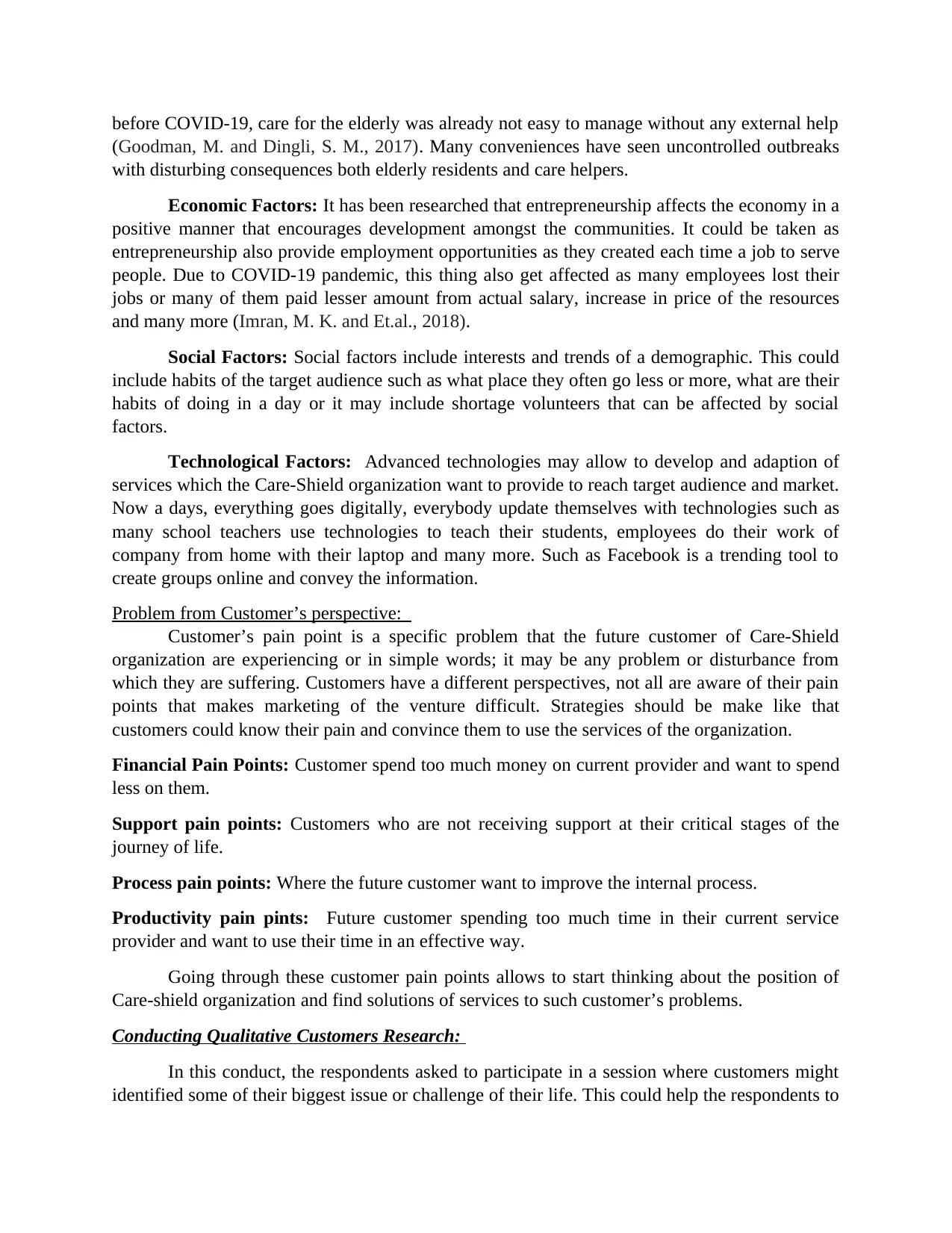
before COVID-19, care for the elderly was already not easy to manage without any external help
(Goodman, M. and Dingli, S. M., 2017). Many conveniences have seen uncontrolled outbreaks
with disturbing consequences both elderly residents and care helpers.
Economic Factors: It has been researched that entrepreneurship affects the economy in a
positive manner that encourages development amongst the communities. It could be taken as
entrepreneurship also provide employment opportunities as they created each time a job to serve
people. Due to COVID-19 pandemic, this thing also get affected as many employees lost their
jobs or many of them paid lesser amount from actual salary, increase in price of the resources
and many more (Imran, M. K. and Et.al., 2018).
Social Factors: Social factors include interests and trends of a demographic. This could
include habits of the target audience such as what place they often go less or more, what are their
habits of doing in a day or it may include shortage volunteers that can be affected by social
factors.
Technological Factors: Advanced technologies may allow to develop and adaption of
services which the Care-Shield organization want to provide to reach target audience and market.
Now a days, everything goes digitally, everybody update themselves with technologies such as
many school teachers use technologies to teach their students, employees do their work of
company from home with their laptop and many more. Such as Facebook is a trending tool to
create groups online and convey the information.
Problem from Customer’s perspective:
Customer’s pain point is a specific problem that the future customer of Care-Shield
organization are experiencing or in simple words; it may be any problem or disturbance from
which they are suffering. Customers have a different perspectives, not all are aware of their pain
points that makes marketing of the venture difficult. Strategies should be make like that
customers could know their pain and convince them to use the services of the organization.
Financial Pain Points: Customer spend too much money on current provider and want to spend
less on them.
Support pain points: Customers who are not receiving support at their critical stages of the
journey of life.
Process pain points: Where the future customer want to improve the internal process.
Productivity pain pints: Future customer spending too much time in their current service
provider and want to use their time in an effective way.
Going through these customer pain points allows to start thinking about the position of
Care-shield organization and find solutions of services to such customer’s problems.
Conducting Qualitative Customers Research:
In this conduct, the respondents asked to participate in a session where customers might
identified some of their biggest issue or challenge of their life. This could help the respondents to
(Goodman, M. and Dingli, S. M., 2017). Many conveniences have seen uncontrolled outbreaks
with disturbing consequences both elderly residents and care helpers.
Economic Factors: It has been researched that entrepreneurship affects the economy in a
positive manner that encourages development amongst the communities. It could be taken as
entrepreneurship also provide employment opportunities as they created each time a job to serve
people. Due to COVID-19 pandemic, this thing also get affected as many employees lost their
jobs or many of them paid lesser amount from actual salary, increase in price of the resources
and many more (Imran, M. K. and Et.al., 2018).
Social Factors: Social factors include interests and trends of a demographic. This could
include habits of the target audience such as what place they often go less or more, what are their
habits of doing in a day or it may include shortage volunteers that can be affected by social
factors.
Technological Factors: Advanced technologies may allow to develop and adaption of
services which the Care-Shield organization want to provide to reach target audience and market.
Now a days, everything goes digitally, everybody update themselves with technologies such as
many school teachers use technologies to teach their students, employees do their work of
company from home with their laptop and many more. Such as Facebook is a trending tool to
create groups online and convey the information.
Problem from Customer’s perspective:
Customer’s pain point is a specific problem that the future customer of Care-Shield
organization are experiencing or in simple words; it may be any problem or disturbance from
which they are suffering. Customers have a different perspectives, not all are aware of their pain
points that makes marketing of the venture difficult. Strategies should be make like that
customers could know their pain and convince them to use the services of the organization.
Financial Pain Points: Customer spend too much money on current provider and want to spend
less on them.
Support pain points: Customers who are not receiving support at their critical stages of the
journey of life.
Process pain points: Where the future customer want to improve the internal process.
Productivity pain pints: Future customer spending too much time in their current service
provider and want to use their time in an effective way.
Going through these customer pain points allows to start thinking about the position of
Care-shield organization and find solutions of services to such customer’s problems.
Conducting Qualitative Customers Research:
In this conduct, the respondents asked to participate in a session where customers might
identified some of their biggest issue or challenge of their life. This could help the respondents to
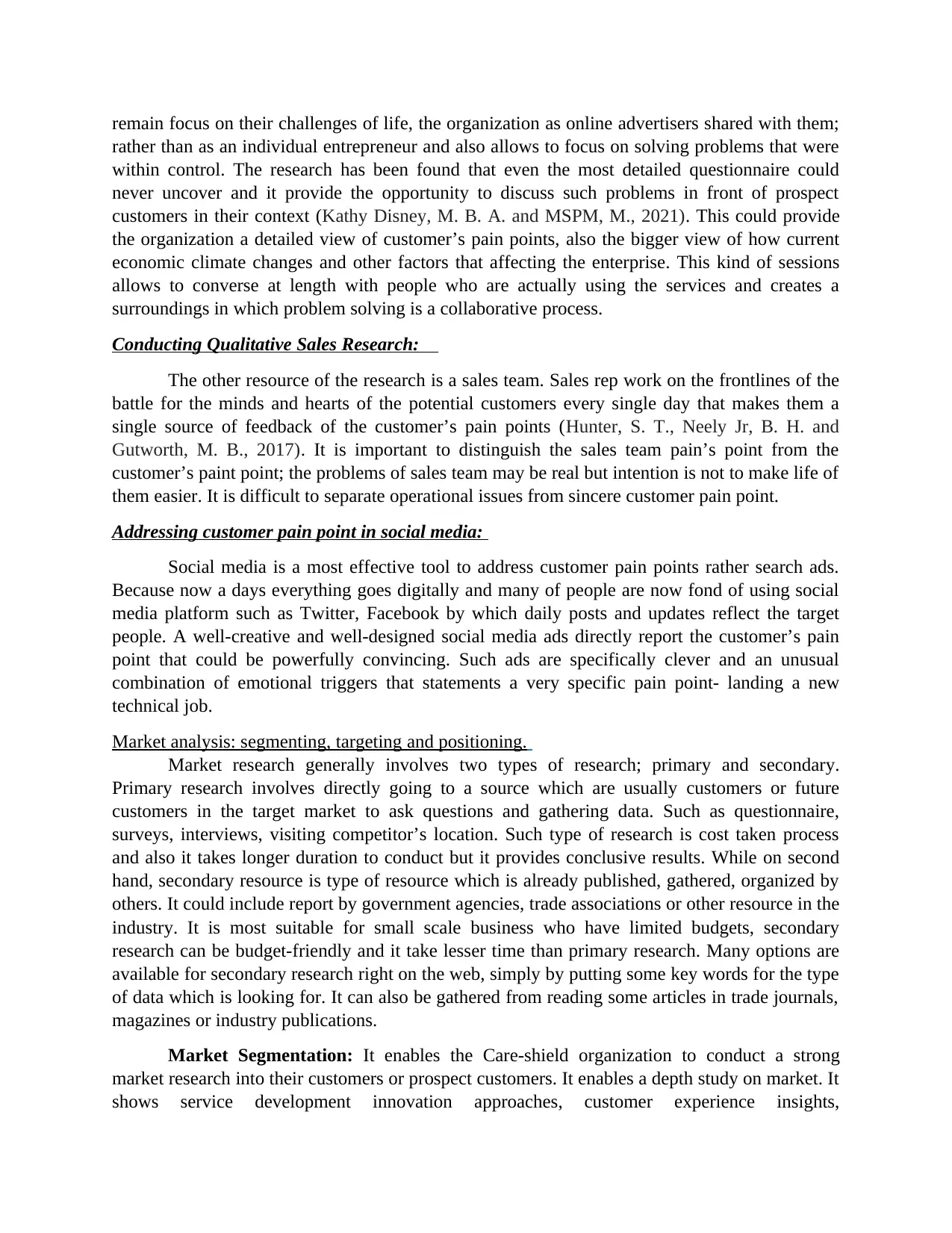
remain focus on their challenges of life, the organization as online advertisers shared with them;
rather than as an individual entrepreneur and also allows to focus on solving problems that were
within control. The research has been found that even the most detailed questionnaire could
never uncover and it provide the opportunity to discuss such problems in front of prospect
customers in their context (Kathy Disney, M. B. A. and MSPM, M., 2021). This could provide
the organization a detailed view of customer’s pain points, also the bigger view of how current
economic climate changes and other factors that affecting the enterprise. This kind of sessions
allows to converse at length with people who are actually using the services and creates a
surroundings in which problem solving is a collaborative process.
Conducting Qualitative Sales Research:
The other resource of the research is a sales team. Sales rep work on the frontlines of the
battle for the minds and hearts of the potential customers every single day that makes them a
single source of feedback of the customer’s pain points (Hunter, S. T., Neely Jr, B. H. and
Gutworth, M. B., 2017). It is important to distinguish the sales team pain’s point from the
customer’s paint point; the problems of sales team may be real but intention is not to make life of
them easier. It is difficult to separate operational issues from sincere customer pain point.
Addressing customer pain point in social media:
Social media is a most effective tool to address customer pain points rather search ads.
Because now a days everything goes digitally and many of people are now fond of using social
media platform such as Twitter, Facebook by which daily posts and updates reflect the target
people. A well-creative and well-designed social media ads directly report the customer’s pain
point that could be powerfully convincing. Such ads are specifically clever and an unusual
combination of emotional triggers that statements a very specific pain point- landing a new
technical job.
Market analysis: segmenting, targeting and positioning.
Market research generally involves two types of research; primary and secondary.
Primary research involves directly going to a source which are usually customers or future
customers in the target market to ask questions and gathering data. Such as questionnaire,
surveys, interviews, visiting competitor’s location. Such type of research is cost taken process
and also it takes longer duration to conduct but it provides conclusive results. While on second
hand, secondary resource is type of resource which is already published, gathered, organized by
others. It could include report by government agencies, trade associations or other resource in the
industry. It is most suitable for small scale business who have limited budgets, secondary
research can be budget-friendly and it take lesser time than primary research. Many options are
available for secondary research right on the web, simply by putting some key words for the type
of data which is looking for. It can also be gathered from reading some articles in trade journals,
magazines or industry publications.
Market Segmentation: It enables the Care-shield organization to conduct a strong
market research into their customers or prospect customers. It enables a depth study on market. It
shows service development innovation approaches, customer experience insights,
rather than as an individual entrepreneur and also allows to focus on solving problems that were
within control. The research has been found that even the most detailed questionnaire could
never uncover and it provide the opportunity to discuss such problems in front of prospect
customers in their context (Kathy Disney, M. B. A. and MSPM, M., 2021). This could provide
the organization a detailed view of customer’s pain points, also the bigger view of how current
economic climate changes and other factors that affecting the enterprise. This kind of sessions
allows to converse at length with people who are actually using the services and creates a
surroundings in which problem solving is a collaborative process.
Conducting Qualitative Sales Research:
The other resource of the research is a sales team. Sales rep work on the frontlines of the
battle for the minds and hearts of the potential customers every single day that makes them a
single source of feedback of the customer’s pain points (Hunter, S. T., Neely Jr, B. H. and
Gutworth, M. B., 2017). It is important to distinguish the sales team pain’s point from the
customer’s paint point; the problems of sales team may be real but intention is not to make life of
them easier. It is difficult to separate operational issues from sincere customer pain point.
Addressing customer pain point in social media:
Social media is a most effective tool to address customer pain points rather search ads.
Because now a days everything goes digitally and many of people are now fond of using social
media platform such as Twitter, Facebook by which daily posts and updates reflect the target
people. A well-creative and well-designed social media ads directly report the customer’s pain
point that could be powerfully convincing. Such ads are specifically clever and an unusual
combination of emotional triggers that statements a very specific pain point- landing a new
technical job.
Market analysis: segmenting, targeting and positioning.
Market research generally involves two types of research; primary and secondary.
Primary research involves directly going to a source which are usually customers or future
customers in the target market to ask questions and gathering data. Such as questionnaire,
surveys, interviews, visiting competitor’s location. Such type of research is cost taken process
and also it takes longer duration to conduct but it provides conclusive results. While on second
hand, secondary resource is type of resource which is already published, gathered, organized by
others. It could include report by government agencies, trade associations or other resource in the
industry. It is most suitable for small scale business who have limited budgets, secondary
research can be budget-friendly and it take lesser time than primary research. Many options are
available for secondary research right on the web, simply by putting some key words for the type
of data which is looking for. It can also be gathered from reading some articles in trade journals,
magazines or industry publications.
Market Segmentation: It enables the Care-shield organization to conduct a strong
market research into their customers or prospect customers. It enables a depth study on market. It
shows service development innovation approaches, customer experience insights,
⊘ This is a preview!⊘
Do you want full access?
Subscribe today to unlock all pages.

Trusted by 1+ million students worldwide
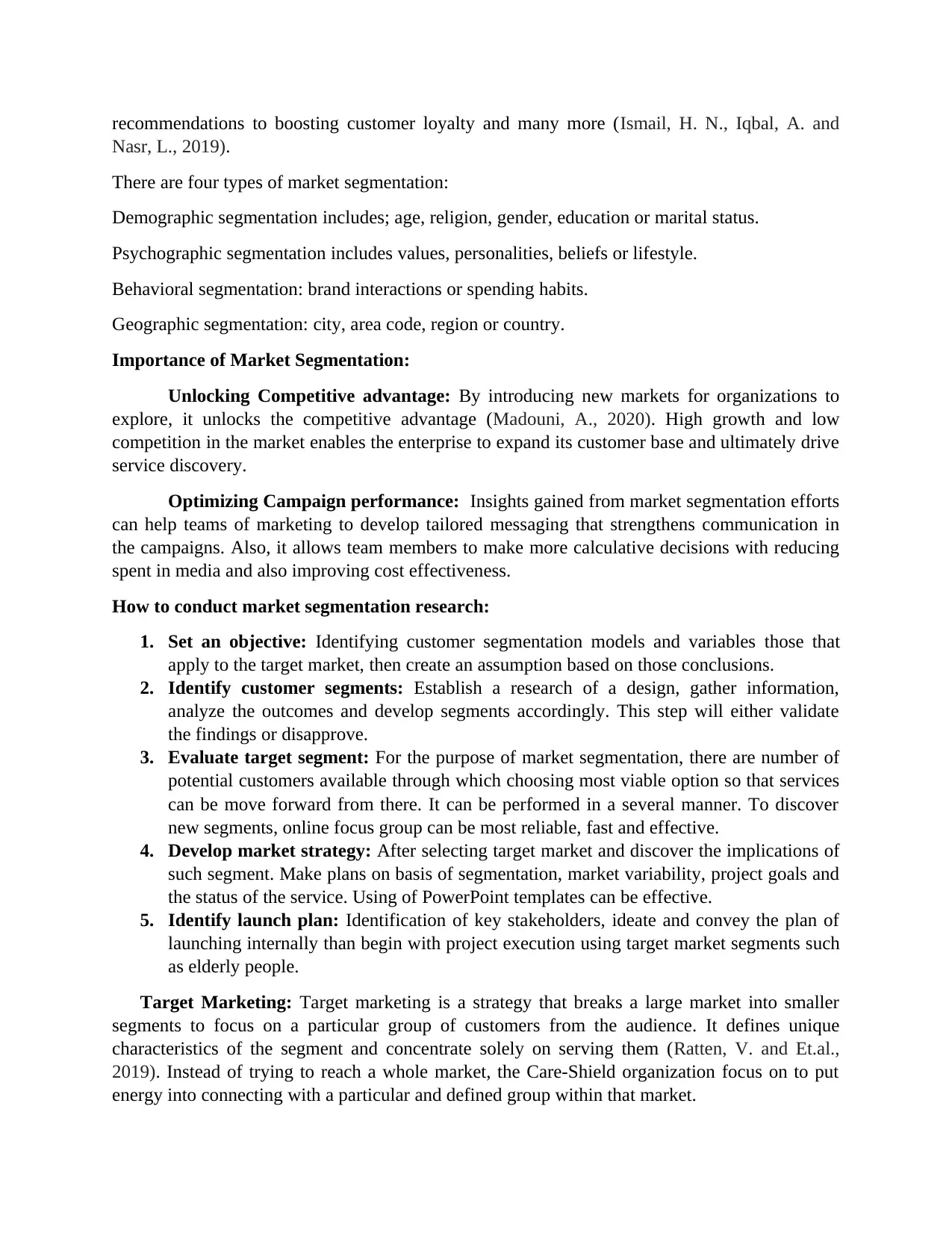
recommendations to boosting customer loyalty and many more (Ismail, H. N., Iqbal, A. and
Nasr, L., 2019).
There are four types of market segmentation:
Demographic segmentation includes; age, religion, gender, education or marital status.
Psychographic segmentation includes values, personalities, beliefs or lifestyle.
Behavioral segmentation: brand interactions or spending habits.
Geographic segmentation: city, area code, region or country.
Importance of Market Segmentation:
Unlocking Competitive advantage: By introducing new markets for organizations to
explore, it unlocks the competitive advantage (Madouni, A., 2020). High growth and low
competition in the market enables the enterprise to expand its customer base and ultimately drive
service discovery.
Optimizing Campaign performance: Insights gained from market segmentation efforts
can help teams of marketing to develop tailored messaging that strengthens communication in
the campaigns. Also, it allows team members to make more calculative decisions with reducing
spent in media and also improving cost effectiveness.
How to conduct market segmentation research:
1. Set an objective: Identifying customer segmentation models and variables those that
apply to the target market, then create an assumption based on those conclusions.
2. Identify customer segments: Establish a research of a design, gather information,
analyze the outcomes and develop segments accordingly. This step will either validate
the findings or disapprove.
3. Evaluate target segment: For the purpose of market segmentation, there are number of
potential customers available through which choosing most viable option so that services
can be move forward from there. It can be performed in a several manner. To discover
new segments, online focus group can be most reliable, fast and effective.
4. Develop market strategy: After selecting target market and discover the implications of
such segment. Make plans on basis of segmentation, market variability, project goals and
the status of the service. Using of PowerPoint templates can be effective.
5. Identify launch plan: Identification of key stakeholders, ideate and convey the plan of
launching internally than begin with project execution using target market segments such
as elderly people.
Target Marketing: Target marketing is a strategy that breaks a large market into smaller
segments to focus on a particular group of customers from the audience. It defines unique
characteristics of the segment and concentrate solely on serving them (Ratten, V. and Et.al.,
2019). Instead of trying to reach a whole market, the Care-Shield organization focus on to put
energy into connecting with a particular and defined group within that market.
Nasr, L., 2019).
There are four types of market segmentation:
Demographic segmentation includes; age, religion, gender, education or marital status.
Psychographic segmentation includes values, personalities, beliefs or lifestyle.
Behavioral segmentation: brand interactions or spending habits.
Geographic segmentation: city, area code, region or country.
Importance of Market Segmentation:
Unlocking Competitive advantage: By introducing new markets for organizations to
explore, it unlocks the competitive advantage (Madouni, A., 2020). High growth and low
competition in the market enables the enterprise to expand its customer base and ultimately drive
service discovery.
Optimizing Campaign performance: Insights gained from market segmentation efforts
can help teams of marketing to develop tailored messaging that strengthens communication in
the campaigns. Also, it allows team members to make more calculative decisions with reducing
spent in media and also improving cost effectiveness.
How to conduct market segmentation research:
1. Set an objective: Identifying customer segmentation models and variables those that
apply to the target market, then create an assumption based on those conclusions.
2. Identify customer segments: Establish a research of a design, gather information,
analyze the outcomes and develop segments accordingly. This step will either validate
the findings or disapprove.
3. Evaluate target segment: For the purpose of market segmentation, there are number of
potential customers available through which choosing most viable option so that services
can be move forward from there. It can be performed in a several manner. To discover
new segments, online focus group can be most reliable, fast and effective.
4. Develop market strategy: After selecting target market and discover the implications of
such segment. Make plans on basis of segmentation, market variability, project goals and
the status of the service. Using of PowerPoint templates can be effective.
5. Identify launch plan: Identification of key stakeholders, ideate and convey the plan of
launching internally than begin with project execution using target market segments such
as elderly people.
Target Marketing: Target marketing is a strategy that breaks a large market into smaller
segments to focus on a particular group of customers from the audience. It defines unique
characteristics of the segment and concentrate solely on serving them (Ratten, V. and Et.al.,
2019). Instead of trying to reach a whole market, the Care-Shield organization focus on to put
energy into connecting with a particular and defined group within that market.
Paraphrase This Document
Need a fresh take? Get an instant paraphrase of this document with our AI Paraphraser
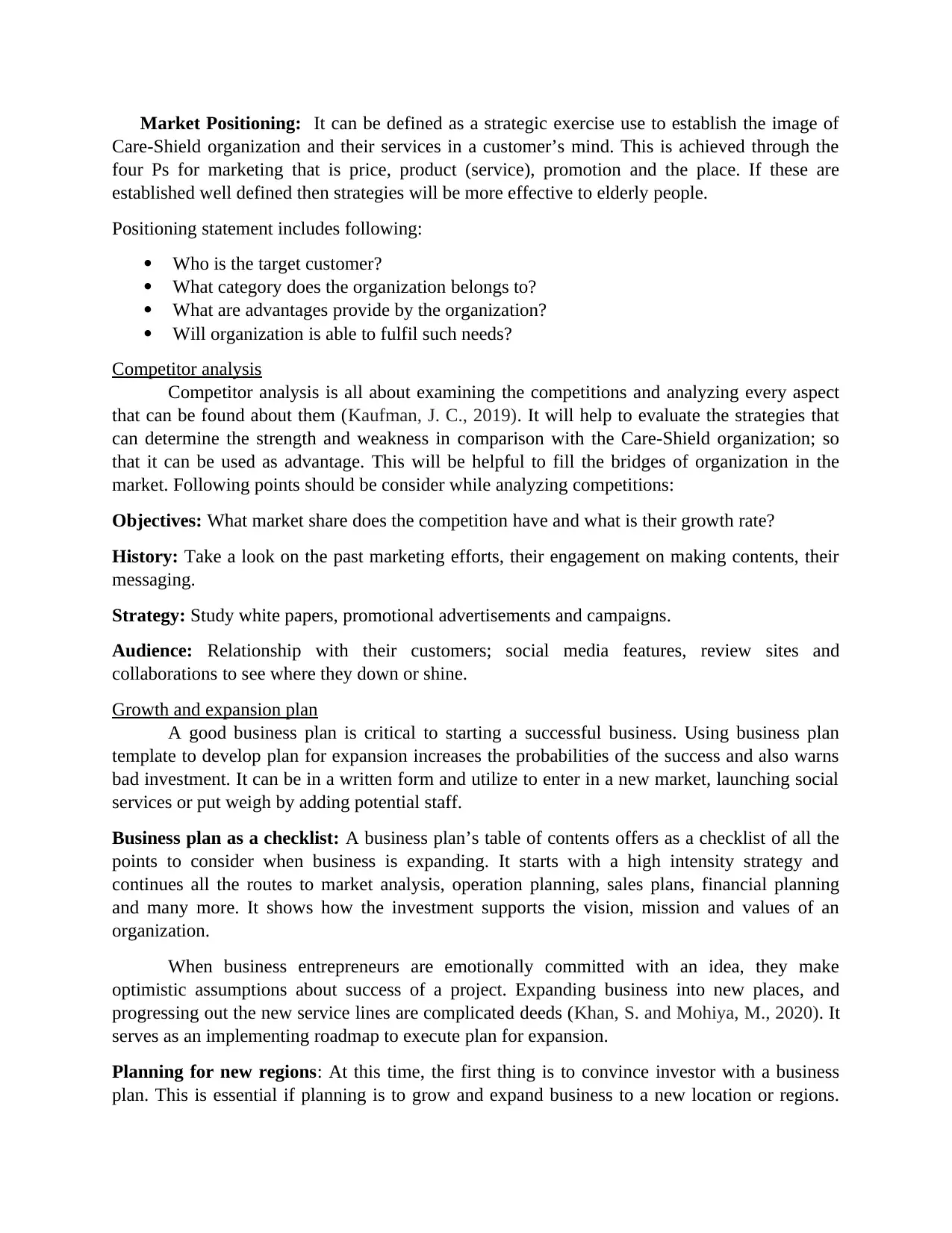
Market Positioning: It can be defined as a strategic exercise use to establish the image of
Care-Shield organization and their services in a customer’s mind. This is achieved through the
four Ps for marketing that is price, product (service), promotion and the place. If these are
established well defined then strategies will be more effective to elderly people.
Positioning statement includes following:
Who is the target customer?
What category does the organization belongs to?
What are advantages provide by the organization?
Will organization is able to fulfil such needs?
Competitor analysis
Competitor analysis is all about examining the competitions and analyzing every aspect
that can be found about them (Kaufman, J. C., 2019). It will help to evaluate the strategies that
can determine the strength and weakness in comparison with the Care-Shield organization; so
that it can be used as advantage. This will be helpful to fill the bridges of organization in the
market. Following points should be consider while analyzing competitions:
Objectives: What market share does the competition have and what is their growth rate?
History: Take a look on the past marketing efforts, their engagement on making contents, their
messaging.
Strategy: Study white papers, promotional advertisements and campaigns.
Audience: Relationship with their customers; social media features, review sites and
collaborations to see where they down or shine.
Growth and expansion plan
A good business plan is critical to starting a successful business. Using business plan
template to develop plan for expansion increases the probabilities of the success and also warns
bad investment. It can be in a written form and utilize to enter in a new market, launching social
services or put weigh by adding potential staff.
Business plan as a checklist: A business plan’s table of contents offers as a checklist of all the
points to consider when business is expanding. It starts with a high intensity strategy and
continues all the routes to market analysis, operation planning, sales plans, financial planning
and many more. It shows how the investment supports the vision, mission and values of an
organization.
When business entrepreneurs are emotionally committed with an idea, they make
optimistic assumptions about success of a project. Expanding business into new places, and
progressing out the new service lines are complicated deeds (Khan, S. and Mohiya, M., 2020). It
serves as an implementing roadmap to execute plan for expansion.
Planning for new regions: At this time, the first thing is to convince investor with a business
plan. This is essential if planning is to grow and expand business to a new location or regions.
Care-Shield organization and their services in a customer’s mind. This is achieved through the
four Ps for marketing that is price, product (service), promotion and the place. If these are
established well defined then strategies will be more effective to elderly people.
Positioning statement includes following:
Who is the target customer?
What category does the organization belongs to?
What are advantages provide by the organization?
Will organization is able to fulfil such needs?
Competitor analysis
Competitor analysis is all about examining the competitions and analyzing every aspect
that can be found about them (Kaufman, J. C., 2019). It will help to evaluate the strategies that
can determine the strength and weakness in comparison with the Care-Shield organization; so
that it can be used as advantage. This will be helpful to fill the bridges of organization in the
market. Following points should be consider while analyzing competitions:
Objectives: What market share does the competition have and what is their growth rate?
History: Take a look on the past marketing efforts, their engagement on making contents, their
messaging.
Strategy: Study white papers, promotional advertisements and campaigns.
Audience: Relationship with their customers; social media features, review sites and
collaborations to see where they down or shine.
Growth and expansion plan
A good business plan is critical to starting a successful business. Using business plan
template to develop plan for expansion increases the probabilities of the success and also warns
bad investment. It can be in a written form and utilize to enter in a new market, launching social
services or put weigh by adding potential staff.
Business plan as a checklist: A business plan’s table of contents offers as a checklist of all the
points to consider when business is expanding. It starts with a high intensity strategy and
continues all the routes to market analysis, operation planning, sales plans, financial planning
and many more. It shows how the investment supports the vision, mission and values of an
organization.
When business entrepreneurs are emotionally committed with an idea, they make
optimistic assumptions about success of a project. Expanding business into new places, and
progressing out the new service lines are complicated deeds (Khan, S. and Mohiya, M., 2020). It
serves as an implementing roadmap to execute plan for expansion.
Planning for new regions: At this time, the first thing is to convince investor with a business
plan. This is essential if planning is to grow and expand business to a new location or regions.
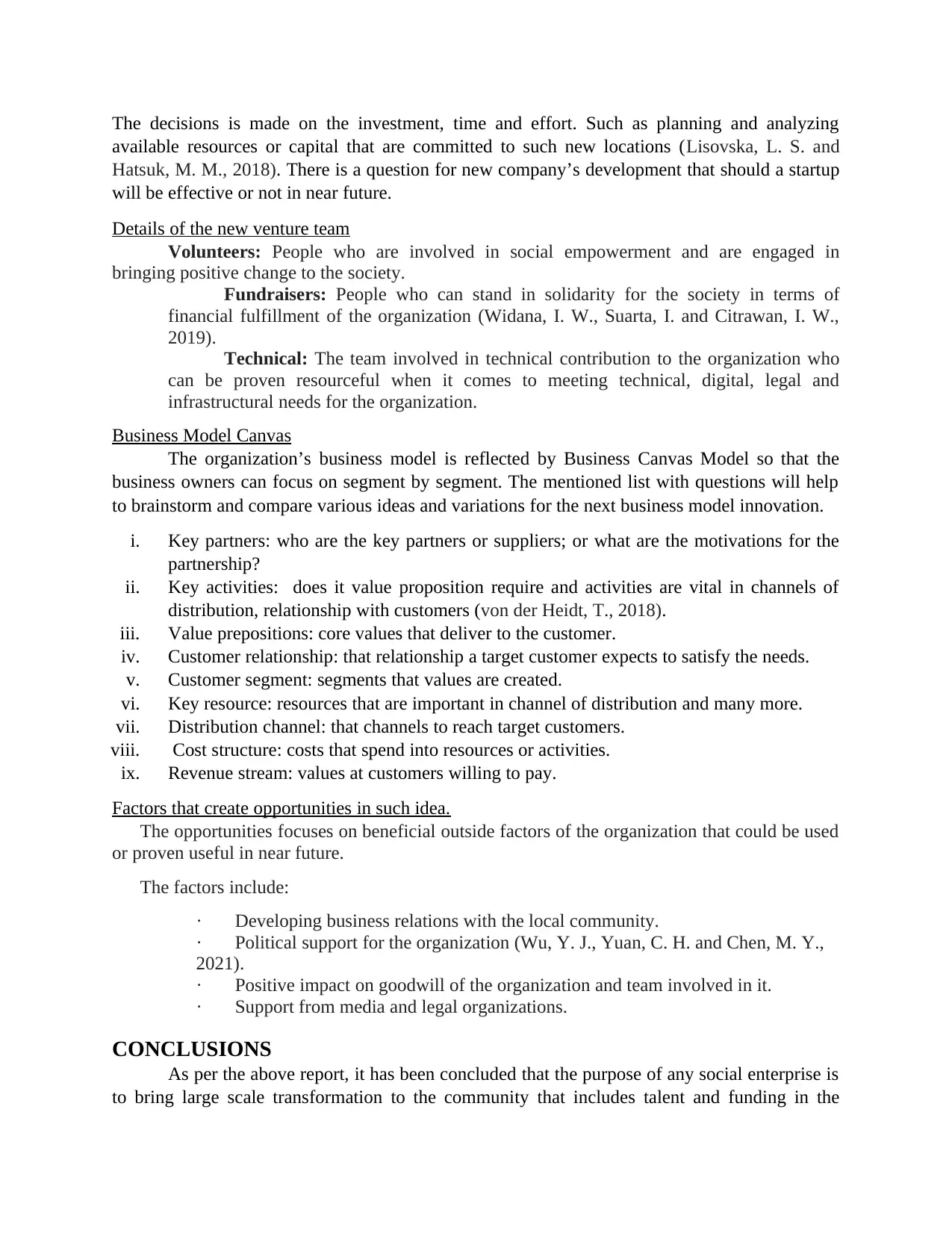
The decisions is made on the investment, time and effort. Such as planning and analyzing
available resources or capital that are committed to such new locations (Lisovska, L. S. and
Hatsuk, M. M., 2018). There is a question for new company’s development that should a startup
will be effective or not in near future.
Details of the new venture team
Volunteers: People who are involved in social empowerment and are engaged in
bringing positive change to the society.
Fundraisers: People who can stand in solidarity for the society in terms of
financial fulfillment of the organization (Widana, I. W., Suarta, I. and Citrawan, I. W.,
2019).
Technical: The team involved in technical contribution to the organization who
can be proven resourceful when it comes to meeting technical, digital, legal and
infrastructural needs for the organization.
Business Model Canvas
The organization’s business model is reflected by Business Canvas Model so that the
business owners can focus on segment by segment. The mentioned list with questions will help
to brainstorm and compare various ideas and variations for the next business model innovation.
i. Key partners: who are the key partners or suppliers; or what are the motivations for the
partnership?
ii. Key activities: does it value proposition require and activities are vital in channels of
distribution, relationship with customers (von der Heidt, T., 2018).
iii. Value prepositions: core values that deliver to the customer.
iv. Customer relationship: that relationship a target customer expects to satisfy the needs.
v. Customer segment: segments that values are created.
vi. Key resource: resources that are important in channel of distribution and many more.
vii. Distribution channel: that channels to reach target customers.
viii. Cost structure: costs that spend into resources or activities.
ix. Revenue stream: values at customers willing to pay.
Factors that create opportunities in such idea.
The opportunities focuses on beneficial outside factors of the organization that could be used
or proven useful in near future.
The factors include:
· Developing business relations with the local community.
· Political support for the organization (Wu, Y. J., Yuan, C. H. and Chen, M. Y.,
2021).
· Positive impact on goodwill of the organization and team involved in it.
· Support from media and legal organizations.
CONCLUSIONS
As per the above report, it has been concluded that the purpose of any social enterprise is
to bring large scale transformation to the community that includes talent and funding in the
available resources or capital that are committed to such new locations (Lisovska, L. S. and
Hatsuk, M. M., 2018). There is a question for new company’s development that should a startup
will be effective or not in near future.
Details of the new venture team
Volunteers: People who are involved in social empowerment and are engaged in
bringing positive change to the society.
Fundraisers: People who can stand in solidarity for the society in terms of
financial fulfillment of the organization (Widana, I. W., Suarta, I. and Citrawan, I. W.,
2019).
Technical: The team involved in technical contribution to the organization who
can be proven resourceful when it comes to meeting technical, digital, legal and
infrastructural needs for the organization.
Business Model Canvas
The organization’s business model is reflected by Business Canvas Model so that the
business owners can focus on segment by segment. The mentioned list with questions will help
to brainstorm and compare various ideas and variations for the next business model innovation.
i. Key partners: who are the key partners or suppliers; or what are the motivations for the
partnership?
ii. Key activities: does it value proposition require and activities are vital in channels of
distribution, relationship with customers (von der Heidt, T., 2018).
iii. Value prepositions: core values that deliver to the customer.
iv. Customer relationship: that relationship a target customer expects to satisfy the needs.
v. Customer segment: segments that values are created.
vi. Key resource: resources that are important in channel of distribution and many more.
vii. Distribution channel: that channels to reach target customers.
viii. Cost structure: costs that spend into resources or activities.
ix. Revenue stream: values at customers willing to pay.
Factors that create opportunities in such idea.
The opportunities focuses on beneficial outside factors of the organization that could be used
or proven useful in near future.
The factors include:
· Developing business relations with the local community.
· Political support for the organization (Wu, Y. J., Yuan, C. H. and Chen, M. Y.,
2021).
· Positive impact on goodwill of the organization and team involved in it.
· Support from media and legal organizations.
CONCLUSIONS
As per the above report, it has been concluded that the purpose of any social enterprise is
to bring large scale transformation to the community that includes talent and funding in the
⊘ This is a preview!⊘
Do you want full access?
Subscribe today to unlock all pages.

Trusted by 1+ million students worldwide
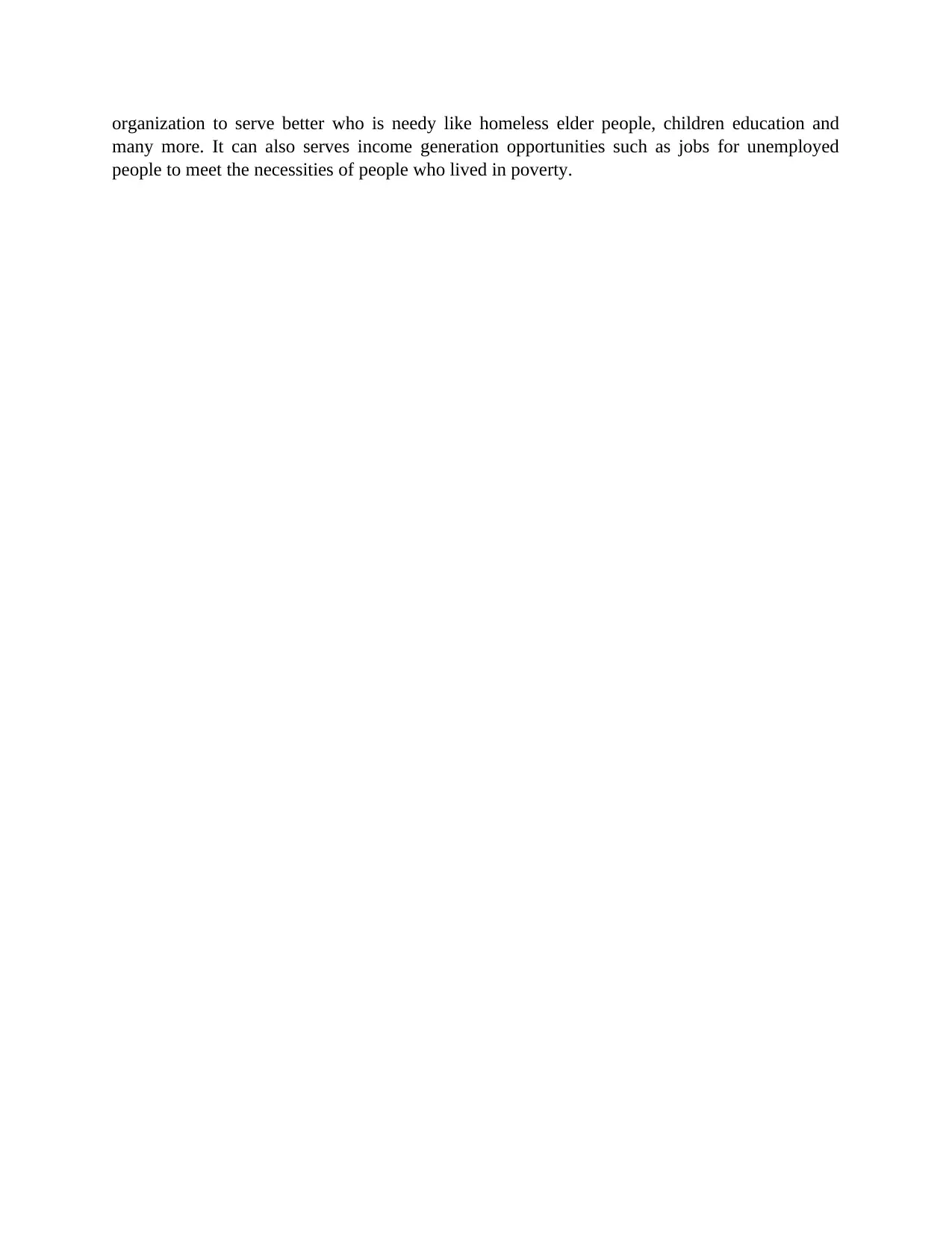
organization to serve better who is needy like homeless elder people, children education and
many more. It can also serves income generation opportunities such as jobs for unemployed
people to meet the necessities of people who lived in poverty.
many more. It can also serves income generation opportunities such as jobs for unemployed
people to meet the necessities of people who lived in poverty.
Paraphrase This Document
Need a fresh take? Get an instant paraphrase of this document with our AI Paraphraser
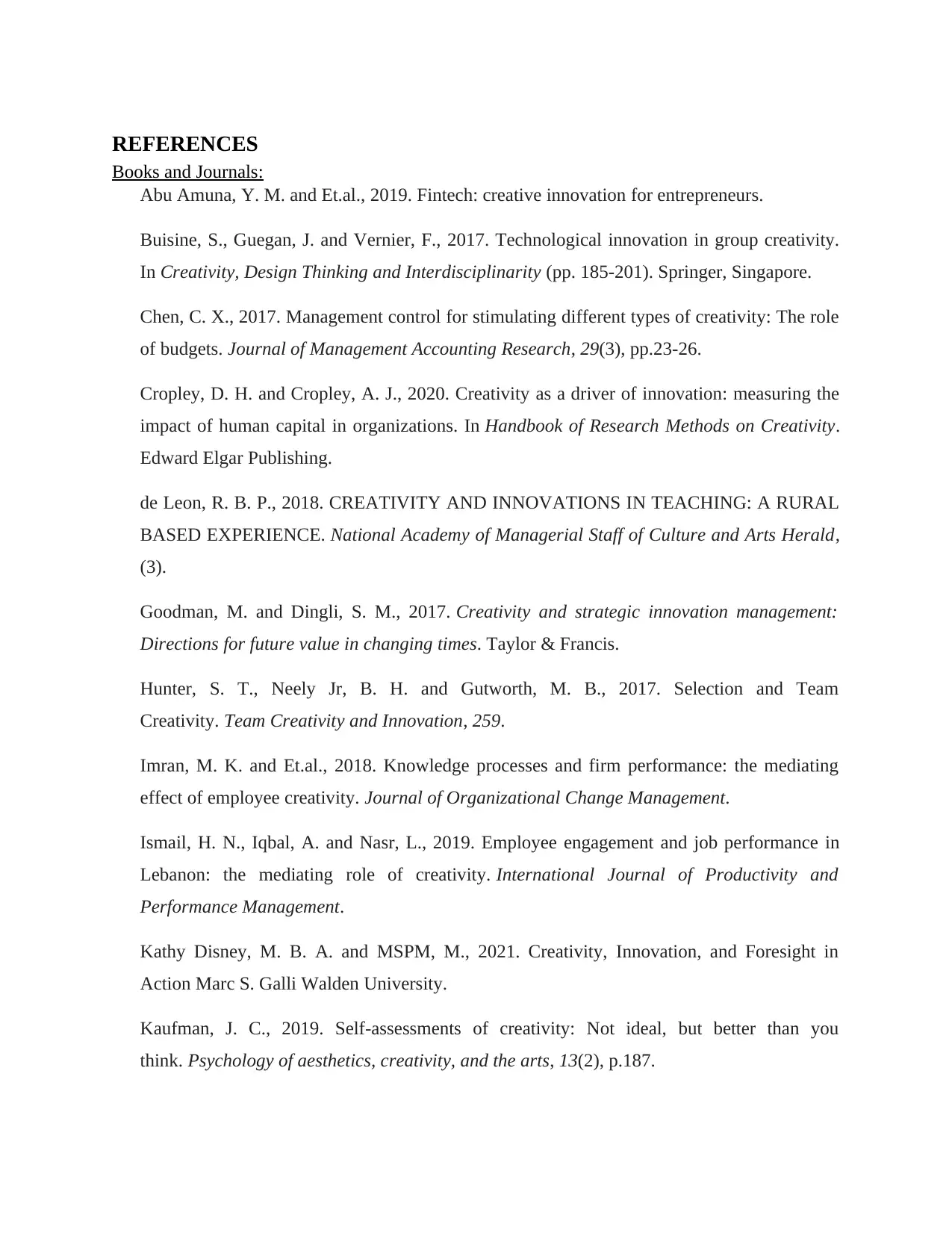
REFERENCES
Books and Journals:
Abu Amuna, Y. M. and Et.al., 2019. Fintech: creative innovation for entrepreneurs.
Buisine, S., Guegan, J. and Vernier, F., 2017. Technological innovation in group creativity.
In Creativity, Design Thinking and Interdisciplinarity (pp. 185-201). Springer, Singapore.
Chen, C. X., 2017. Management control for stimulating different types of creativity: The role
of budgets. Journal of Management Accounting Research, 29(3), pp.23-26.
Cropley, D. H. and Cropley, A. J., 2020. Creativity as a driver of innovation: measuring the
impact of human capital in organizations. In Handbook of Research Methods on Creativity.
Edward Elgar Publishing.
de Leon, R. B. P., 2018. CREATIVITY AND INNOVATIONS IN TEACHING: A RURAL
BASED EXPERIENCE. National Academy of Managerial Staff of Culture and Arts Herald,
(3).
Goodman, M. and Dingli, S. M., 2017. Creativity and strategic innovation management:
Directions for future value in changing times. Taylor & Francis.
Hunter, S. T., Neely Jr, B. H. and Gutworth, M. B., 2017. Selection and Team
Creativity. Team Creativity and Innovation, 259.
Imran, M. K. and Et.al., 2018. Knowledge processes and firm performance: the mediating
effect of employee creativity. Journal of Organizational Change Management.
Ismail, H. N., Iqbal, A. and Nasr, L., 2019. Employee engagement and job performance in
Lebanon: the mediating role of creativity. International Journal of Productivity and
Performance Management.
Kathy Disney, M. B. A. and MSPM, M., 2021. Creativity, Innovation, and Foresight in
Action Marc S. Galli Walden University.
Kaufman, J. C., 2019. Self-assessments of creativity: Not ideal, but better than you
think. Psychology of aesthetics, creativity, and the arts, 13(2), p.187.
Books and Journals:
Abu Amuna, Y. M. and Et.al., 2019. Fintech: creative innovation for entrepreneurs.
Buisine, S., Guegan, J. and Vernier, F., 2017. Technological innovation in group creativity.
In Creativity, Design Thinking and Interdisciplinarity (pp. 185-201). Springer, Singapore.
Chen, C. X., 2017. Management control for stimulating different types of creativity: The role
of budgets. Journal of Management Accounting Research, 29(3), pp.23-26.
Cropley, D. H. and Cropley, A. J., 2020. Creativity as a driver of innovation: measuring the
impact of human capital in organizations. In Handbook of Research Methods on Creativity.
Edward Elgar Publishing.
de Leon, R. B. P., 2018. CREATIVITY AND INNOVATIONS IN TEACHING: A RURAL
BASED EXPERIENCE. National Academy of Managerial Staff of Culture and Arts Herald,
(3).
Goodman, M. and Dingli, S. M., 2017. Creativity and strategic innovation management:
Directions for future value in changing times. Taylor & Francis.
Hunter, S. T., Neely Jr, B. H. and Gutworth, M. B., 2017. Selection and Team
Creativity. Team Creativity and Innovation, 259.
Imran, M. K. and Et.al., 2018. Knowledge processes and firm performance: the mediating
effect of employee creativity. Journal of Organizational Change Management.
Ismail, H. N., Iqbal, A. and Nasr, L., 2019. Employee engagement and job performance in
Lebanon: the mediating role of creativity. International Journal of Productivity and
Performance Management.
Kathy Disney, M. B. A. and MSPM, M., 2021. Creativity, Innovation, and Foresight in
Action Marc S. Galli Walden University.
Kaufman, J. C., 2019. Self-assessments of creativity: Not ideal, but better than you
think. Psychology of aesthetics, creativity, and the arts, 13(2), p.187.
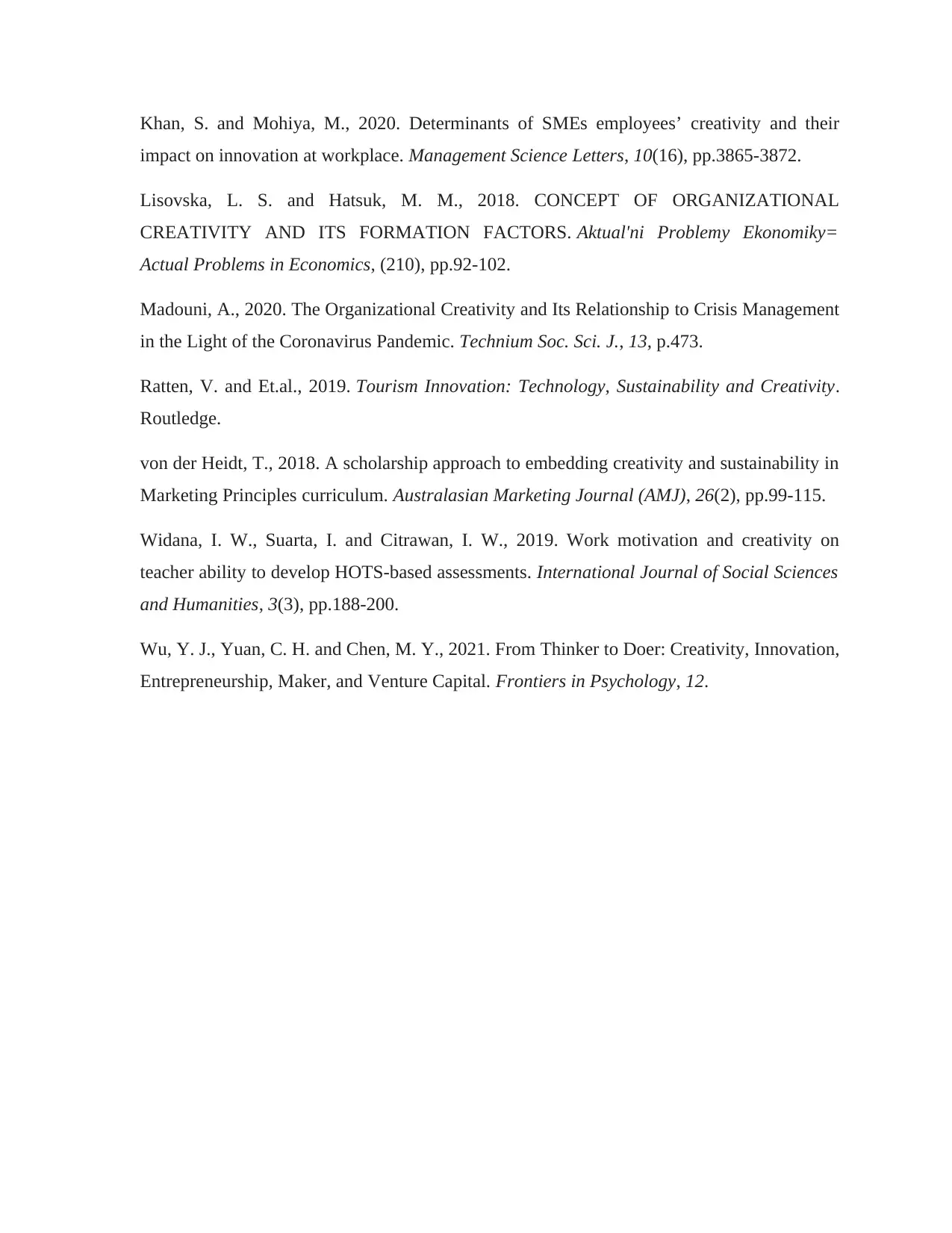
Khan, S. and Mohiya, M., 2020. Determinants of SMEs employees’ creativity and their
impact on innovation at workplace. Management Science Letters, 10(16), pp.3865-3872.
Lisovska, L. S. and Hatsuk, M. M., 2018. CONCEPT OF ORGANIZATIONAL
CREATIVITY AND ITS FORMATION FACTORS. Aktual'ni Problemy Ekonomiky=
Actual Problems in Economics, (210), pp.92-102.
Madouni, A., 2020. The Organizational Creativity and Its Relationship to Crisis Management
in the Light of the Coronavirus Pandemic. Technium Soc. Sci. J., 13, p.473.
Ratten, V. and Et.al., 2019. Tourism Innovation: Technology, Sustainability and Creativity.
Routledge.
von der Heidt, T., 2018. A scholarship approach to embedding creativity and sustainability in
Marketing Principles curriculum. Australasian Marketing Journal (AMJ), 26(2), pp.99-115.
Widana, I. W., Suarta, I. and Citrawan, I. W., 2019. Work motivation and creativity on
teacher ability to develop HOTS-based assessments. International Journal of Social Sciences
and Humanities, 3(3), pp.188-200.
Wu, Y. J., Yuan, C. H. and Chen, M. Y., 2021. From Thinker to Doer: Creativity, Innovation,
Entrepreneurship, Maker, and Venture Capital. Frontiers in Psychology, 12.
impact on innovation at workplace. Management Science Letters, 10(16), pp.3865-3872.
Lisovska, L. S. and Hatsuk, M. M., 2018. CONCEPT OF ORGANIZATIONAL
CREATIVITY AND ITS FORMATION FACTORS. Aktual'ni Problemy Ekonomiky=
Actual Problems in Economics, (210), pp.92-102.
Madouni, A., 2020. The Organizational Creativity and Its Relationship to Crisis Management
in the Light of the Coronavirus Pandemic. Technium Soc. Sci. J., 13, p.473.
Ratten, V. and Et.al., 2019. Tourism Innovation: Technology, Sustainability and Creativity.
Routledge.
von der Heidt, T., 2018. A scholarship approach to embedding creativity and sustainability in
Marketing Principles curriculum. Australasian Marketing Journal (AMJ), 26(2), pp.99-115.
Widana, I. W., Suarta, I. and Citrawan, I. W., 2019. Work motivation and creativity on
teacher ability to develop HOTS-based assessments. International Journal of Social Sciences
and Humanities, 3(3), pp.188-200.
Wu, Y. J., Yuan, C. H. and Chen, M. Y., 2021. From Thinker to Doer: Creativity, Innovation,
Entrepreneurship, Maker, and Venture Capital. Frontiers in Psychology, 12.
⊘ This is a preview!⊘
Do you want full access?
Subscribe today to unlock all pages.

Trusted by 1+ million students worldwide
1 out of 12
Related Documents
Your All-in-One AI-Powered Toolkit for Academic Success.
+13062052269
info@desklib.com
Available 24*7 on WhatsApp / Email
![[object Object]](/_next/static/media/star-bottom.7253800d.svg)
Unlock your academic potential
Copyright © 2020–2025 A2Z Services. All Rights Reserved. Developed and managed by ZUCOL.




